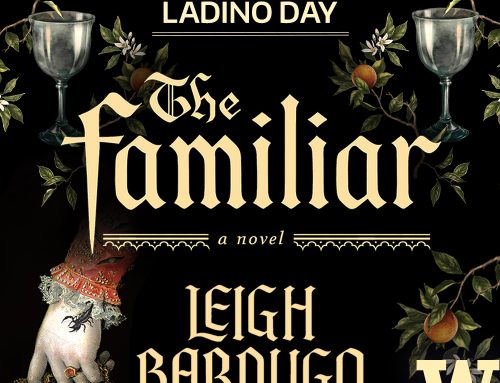We are pleased to share our video recording of the December 6th, 2015 International Ladino Day celebration in Seattle. In 2013, the fifth president of Israel, Yitzhak Navon who also served as the director of the National Authority for Ladino in Jerusalem, endorsed the idea of El Dia Internasional. The idea to hold festivities and to celebrate the Judeo-Spanish language had been proposed on Ladinokomunita by Zelda Ovadia of the Ladino magazine Aki Yerushalayim.
The third annual celebration held here at the University of Washington began with a captivating introduction to Sephardi Lives: A Documentary History, 1700-1950 by the book’s authors Professors Julia Phillips Cohen (Vanderbilt) and Sarah Abrevaya Stein (UCLA, formerly of the UW). This important work, which won the National Jewish Book award in the category of Sephardic culture, contains over 150 excerpts of historical texts dealing with Jewish society, politics, and culture in the former Ottoman Empire. A group of Ladino speakers from the local Sephardic community, Los Ladineros, in conversation with Professors Phillips Cohen and Abreveya Stein, selected six texts originally composed in Ladino and adapted them for the “stage.” They brought these educational and often humorous texts–the words of bygone generations of Ladino-speaking Jews–back to life by presenting adaptations of the original Ladino accompanied by historical illustrations and translations into English for the packed audience to follow along. Professors Phillips Cohen and Abrevaya Stein also provided a scholarly introduction to the program and introduced each selection by situating it in historical context.
The night also featured Ladino proverbs shared by Lela Abravanel; a Ladino song performed by Rabbi Frank Varon, hazzan of Sephardic Bikur Holim, in memory of his late father, Jack Varon, and his dear friend Lucy Kavesh-Benveniste, both Ladineros who had performed at previous Ladino Day events; and an original Ladino poem composed and presented by UW undergraduate student, Ashley Bobman, who drew inspiration from the Ladino poetry of her great-grandfather, the Salonican-born journalist and educator, Albert Levy. The evening concluded with Ladino Hanukkah songs followed by a warm reception with Sephardic delicacies enjoyed by over 400 attendees.
Selected Clips
A Sephardi-Ashkenazi Romance
The first excerpt, entitled Can a Sephardi-Ashkenazi Romance Survive?, was read by Regina Amira, a native of the Island of Rhodes, and her husband Vic Amira, an active member of the Turkish Sephardic Bikur Holim. The text was selected from an advice column La Bos Del Pueblo, a Ladino newspaper published in New York. This excerpt is adapted from a letter to the editor, and the editor’s response, in 1916 from a young Ashkenazi woman who is worried that her parents might object to her love for a young Sephardi man, who, although he claims to be Jewish, does not (heaven forbid) speak Jewish (Yiddish).
La Antipatia por el Kante (The Objections of a Rabbi)
The second selection highlights a dispute between journalist and singer Saadi Besalel a-Levi Ashkenazi and a certain rabbi about the use of Ottoman modes of music in the synagogue liturgy — in this case performed at a wedding. The video La Antipatia por el Kante includes images from the pages of the works published by Saadi a-Levi, now included in the Sephardic Studies Digital Library. This story of Turkish music and Jewish liturgy was read by Isaac Azose, hazzan emeritus of the Rhodesli synagogue Congregation Ezra Bessaroth. Hazzan Azose is the author of a monumental five-volume set of prayer books encompassing all of the Jewish holidays and containing the liturgical texts both in the Turkish and the Rhodes Jewish communities in Seattle in Hebrew, English, and with selections in Ladino. Azose has also produced two double albums, the first containing the liturgical music of these two synagogues, and the other a set of Ladino romansas and folksongs.
La Tia Estamblia
The third video, La Tia Estambolia, is a text borrowed from the pioneering Ladino research of Emma Adatto-Schlesinger, who published her graduate thesis at the University of Washington, “A study of the linguistic characteristics of the Seattle Sefardi Folklore,” in 1935. It’s a vivid portrayal of one of the many interviews she conducted with Ladino speakers in Seattle. Images of Emma’s handwritten notebook, now contained in the Sephardic Studies Digital Library, are presented in the visual display of this presentation. Lily DeJaen, a fluent speaker of Judeo-Spanish, a devoted member of Sephardic Bikur Holim, and an honorary board member dedicated to the work of the Washington State Jewish Historical Society, read this piece.
The Sephardic Studies Program of the Stroum Center for Jewish Studies is grateful to the cosponsors who made this event possible and to all those who gathered to celebrate the language and culture of the Sephardic Jews.
View the full program here!







Leave A Comment